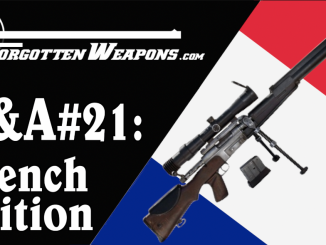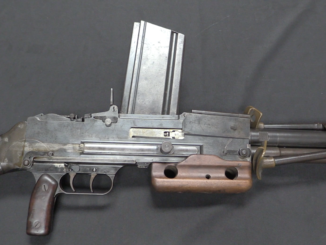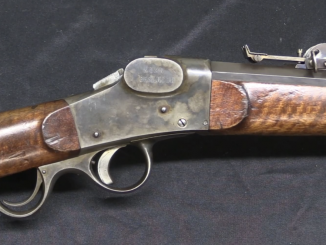Courtesy of PGM Precision USA, we have a chance to take a look at a Hecate II sniper rifle today. This rifle’s story begins with the Ultima Ratio, a classic-based 7.62mm precision rifle designed by Gilles Payen in France circa 1991 for the French RAID police unit. The rifle was very well-received, and Payen partner with colleagues Alain Gonnet and François Morier to form PGM Precision in order to scale the design up to .50 BMG caliber.
The resulting rifle was named the Hecate, and tested by French troops in Sarajevo in 1994. After a few requested changes were made, the improved Hecate II was formally adopted by the French military in 1995. It is built to be a supremely accurate rifle, with an effective range of 1800m, and easily maintained in field conditions. It have been used widely by French forces since its adoption, and also adopted by a variety of other military forces around the world, developing a reputation as the best military .50 caliber precision rifle available.




You should pronounce it Hecatee !
nope. as a French I validate Ian’s pronunciation.
As a native french speaker, I also validate Ian pronunciation.
Little correction regarding the barrel: it is not stellite lined. There is a stelitte insert in the chamber/throat area of the barrel. Tought the full lenght of the bore is chrome lined.
I can also confirm that the muzzle brake is really efficient. Definitly more comfortable to shoot than a heavy 12 gauge hunting load.
A little bit of trivia here: to reduce risk of detached retina, French army snipers are allowed 20 shots of 12.7×99 a day when training and 50 a day in operations.
Thanks for the video, Ian. Very informative.
This is a very bold claim: “(…) developing a reputation as the best military .50 caliber precision rifle available”, but I understand it was mostly intended as a .50 precision rifle, more than just another anti-materiel large caliber rifle… Kudos for the design team!
I remember meeting these guys down here in S. W. France at the Gendarmery training school at ST.Astier. They were trying to sell the idea at that time. What I was interested in was their huge silencer .Really nice guys they even tore it down for me
Silent death that can punch through a wall to get you… that’s pretty terrifying! To make matters worse for the recipient, there is no way to fight back, as the attacks from afar generally coincide with other worries, like getting stabbed in the back! Yes, I merely wrote that prose for laughs.
Never eat at a place called Mom’s, never play cards with a man called “Doc”, and never piss off somebody who can blow your head off from another area code.
cheers
eon
“Why, they couldn’t hit an elephant at THIS distance!” BANG! SPLAT!!
“NOOOO GENERAL!!!”
They were successful in selling the design. Swiss company Brügger & Thomet makes precision rifles based on the Hecate, although I don’t know any further details about their cooperation.
Well, cooperation is not really the word. This look like more a rip-off.
Almost as if the French military is trying to justify Ian’s faith in French weapons
They should give him free week in Riviera
I guess rebels in Sahel love them 🙂
Seriously, would it not be of benefit to have Barrel quick detachable? I suppose it is matter of trade-off; accuracy may not be the same.
Interesting stuff.
The rifle makes a mixed impression.
It was developed explicitly by a person who clearly understands what exactly he wants to get as a result. Although without much effort. Or maybe there was simply not enough time.
First of all, this is in no way a sniper rifle, rather an “anti-material” one.
Destination, shooting at automobile engines and other “hard” objects at relatively small “urban” distances.
For the sniper role, it has the wrong design.
And this is clearly not an army device.
Pretty well implemented concept of STEN. As simple as a hammer. The big hammer … 😉
Functionally and (apparently) not predisposed to various kinds of malfunctions. Made from simple materials on conventional equipment.
Simple, cheap, ugly. And quite consistent with its purpose.
All in all, good work.
Sorry to rain on the parade of several commentators, but “supreme accuracy” and caliber .50 BMG do not go together. Even U.S. Army figures show a considerably larger dispersion compared to other sniper cartridges.
Apart from that, you need to exactly know the distance to your target AND the correct adjustment of your scope for this very distance. Not to mention crosswind, the nemesis of all sniping.
No doubt its a “big hammer”, but the problem remains to hit the correct spot.
There’s a reason people interested in very precise shooting at ridiculously long ranges are looking at other calibers, notably .408 Cheytac (10.16 x 77) and .416 Barrett (10.6 x 83);
https://en.wikipedia.org/wiki/.408_Cheyenne_Tactical
https://en.wikipedia.org/wiki/.416_Barrett
Both were designed for that exact purpose, the .416 at the request of the Naval Surface Warfare Center (Crane Division).
It must be remembered that .50 BMG (12.7 x 99) was never intended for long-range precision work. It was intended initially to kill World War One era tanks, and then adapted to killing airplanes, at comparatively short range (400 meters or less), two jobs it was and still is well suited for.
(The modern equivalent of a WW1 tank, armor-wise, is a typical “light armored vehicle”, and no, LAV and Stryker crews do not like being shot at with “fifties”; AAV-P occupants aren’t too thrilled with it, either.)
Neither mission requires absolute accuracy, in fact, some dispersion is both expected and preferred, especially for the AAA mission; you hunt “game birds” with a shotgun, not a rifle.
For long-range precision shooting, it makes a lot more sense to use a cartridge/rifle combination designed by specialists in…long-range precision shooting. Namely, Cheyenne Tactical and Barrett.
The interesting note is either the .408 CT or the .416 B would make a perfectly effective heavy MG round as well. And would allow an HMG that weighed considerably less than the M2. Adopting either one in that role, with a newly-designed gun built around it (something like the “Dover Devil”.50 or the 25 x 59mm OCSW scaled down to a more reasonable size and weight, for instance)would finally retire the “Ma Deuce” after a century of sterling service- but be more in keeping with modern tactical considerations.
As in, we don’t have as many 40-to-50-ton vehicles to haul them around, these days. Sooner or later, somebody has to actually hump the damned thing.
Lighter gun, lighter ammo equals a lot better mobility on the battlefield. Or even getting to the battlefield in the first place.
cheers
eon
> There’s a reason people interested in very precise shooting at ridiculously long ranges are looking at other calibers, notably .408 Cheytac (10.16 x 77) and .416 Barrett
Yes, primarily because they live in California which bans the .50BMG.
To JPeelen’s point, obviously you won’t get full accuracy out of one of these with unlinked ball ammo from your M2. So.. don’t do that.
“Mobility”, as the military understands it, in this case, does not matter.
This is a police device.
So it should be compact enough to hide it in a sports bag for secretive taking up a position.
It should not be too heavy so that the rent could be run up the stairs to the roof of a skyscraper.
This should be even more foolproof than for the military, because the level of training…
It should be as cheap as possible to use and repair. Therefore, a gun barrel is used (in the worst case).
Finally, versatility. There are many varieties of ammunition with bullets for any need.
And about the “low accuracy of ammunition” is not so. Actually .50 cartridge does not have any organic defects preventing it from being accurate. This is a matter of accurate assembly of cartridge.
What exactly this device “suddenly” turned out to be not too accurate, nothing surprising. This is partly a consequence of the light weight of the rifle. Also, the design contains a number of organic design errors. All together completely eliminates the possibility of truly accurate shooting. Moreover, regardless of the quality of ammo. For their tasks, accuracy is apparently sufficient
So it is valid.
“(…).408 Cheytac (10.16 x 77) and .416 Barrett (10.6 x 83)(…)”
And how does these compare to sniper versions of 12,7×99 cartridge,
for example 12.7x99mm Ball Solid Sniper as shown here:
https://cbcdefense.com/products/caliber/12-7x99mm/
?
Speaking of big hammer, prior to Hecate, during Yugoslavian unpleasantness some French troops were equiped with Mc Millan 50 BMG rifle. Their standard procedure to deal with snipers shooting a random people from high buildings is said to be the following: from the cover of an APC, fire a warning shot from a FR-F1, if not cooperating fire a shot from Mc Millan trough the wall, if still not cooperating send a burst of the 20mm from the auto cannon of the APC trough the same wall where the coward is hiding behind.
They very soon realized that all these warning games were stupid and a waste of time.
The use of .50 and 20mm machine guns, in tandem with ballistic notch stations, quickly reduced the population of plinking fans.
Good point about .50 BMG originally being designed as an anti-tank round during WW1. During the War on Terror (post 2001) .50 BMG rifles were primarily issued as anti-material rifles to explosive ordinance demolition teams. Their primary role was to strip away detonators from road-side bombs … before a man had to take the “long walk.” Sniping was a later role. And yes, several newer, more accurate, large bore rounds have been developed specifically for sniping.
The next person who challenges the accuracy of .50 BMG should be forced to yell his criticism from 1,000 yards, while standing in the open. Pseudo-snipers take pot shots until the critic falls or runs away.
I believe that a fair fight starts with a .50 Browning Heavy Machine Gun … mounted on something like the Lynx that I drove during my first driving lesson.
Master Corporal (retired) Rob Warner CD, BA and a couple pairs of military jump wings.